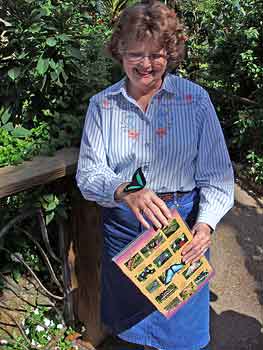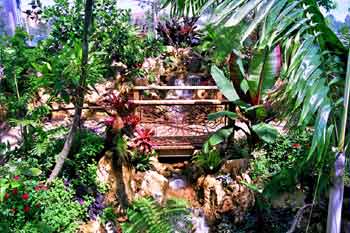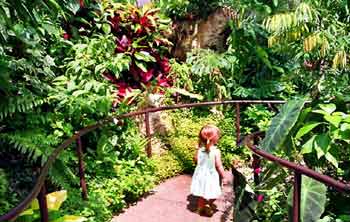The Butterfly Rainforest at the McGuire Center for Lepidoptera and Biodiversity is located at the Florida Museum of Natural History on the University of Florida campus in Gainesville.
Professor Thomas C. Emmel Ph.D. long dreamed of creating a world class institution devoted to the study and conservation of butterflies. With the opening of the new thirteen million dollar McGuire Center his dream has become a reality.
The Butterfly Rainforest ecosystem was designed and constructed in it’s entirety by Bruce J. Morgan of Environmental Designs. I consider it to be my finest project to date.
 |
|
|
|
The vivarium exterior features a 130 foot long tile mosaic by Venezuelan artist Marianna Lerbs. Directly across the plaza from the Butterfly Rainforest is the new Harn Museum of Art
|
|
|
|
|
|
|
|
|
|
|
|
 |
|
|
The McGuire Center has three components, the world’s largest Lepidoptera research facility, a collection second only to The Natural History Museum in London, and the Butterfly Rainforest vivarium which is considered by many to be the most elaborate and beautiful such artificial ecosystem ever created.
|
|
|
|
|
|
|
|
|
 |
|
|
|
The Butterfly Rainforest is a celebration of the beauty of nature and biodiversity. Visitors from around the world wander the winding paths through the lavish rainforest, and leave with a new understanding of the importance of conservation.
|
|
|
|
|
|
|
|
|
|
|
|
 |
|
|
|
The vivarium features over 350 species of rare tropical plants, and hundreds of tons of massive natural stonework. Some of the boulders, such as this one, weigh over five tons apiece. This level of detail and integration can never be achieved with artificial stone.
|
|
|
|
|
|
|
|
|
|
 |
|
|
|
All of the materials used in the Rainforest are real. These are Bromeliads growing on an ancient tree trunk. There are no fake rocks, fiberglass logs, or plastic plants in the Butterfly Rainforest. This isn't Disneyworld, this is the REAL world!
|
|
|
|
|
|
|
|
|
|
|
|
 |
|
|
|
The Rainforest may be a botanist's delight, but most people come to see the butterflies, up to 2000 of which are flying free within the enclosure at any given time. My favorites are the Clearwings!
|
|
|
|
|
|
|
|
|
|
 |
|
|
|
People go wild over the beautiful blue Morpho butterflies from the jungles of South America. You can travel to the Amazon and never even see one, but in the Butterfly Rainforest the morphos will land on your nose!
|
|
|
|
|
|
|
|
|
|
 |
|
|
|
It's all about education. The signs and the butterflies themselves are the only aspects of the Rainforest that I didn't provide.
|
|
|
|
|
|
|
|
|
|
 |
|
|
|
The Rainforest is a synthesis of art and science. The bridges feature wrought iron grillwork in the form of butterflies with stained glass eyespots
|
|
|
|
|
|
|
|
|
|
 |
|
|
|
The Butterfly Rainforest features numerous waterfalls and streams, some large, some small. This is Maidenhair falls
|
|
|
|
|
|
|
|
|
|
 |
|
|
|
I call this one Anthurium falls, but there are so many rare and beautiful species of plants that it is hard to decide what to name it!
|
|
|
|
|
|
|
|
|
|
 |
|
|
|
There are five bridges crossing the various streams. This is a view looking up one of the larger streams taken from the main observation platform.
|
|
|
|
|
|
|
|
|
|
 |
|
|
|
The waterfalls and streams all converge in the central sunken "cenote" pool which is full of fish and kept crystal clear by a low maintenance bio-filtration system.
|
|
|
|
|
|
|
|
|
|
|
|
 |
|
|
|
Like a real rainforest the Butterfly Rainforest is a living ecosystem which constantly changes. In only one year it went from raw dirt and rocks to this, an unprecedented rate of growth.
|
|
|
|
|
|
|
|
|
|
 |
|
|
|
The Butterfly Rainforest has been a great success for the University, drawing paying guests from around the world, and serving as a stimulus for future campus development. Everyone from grumpy scientists to giggling kids love the place. Let your curiosity be your guide!
|
|
|
|
|
|
|
|
|














